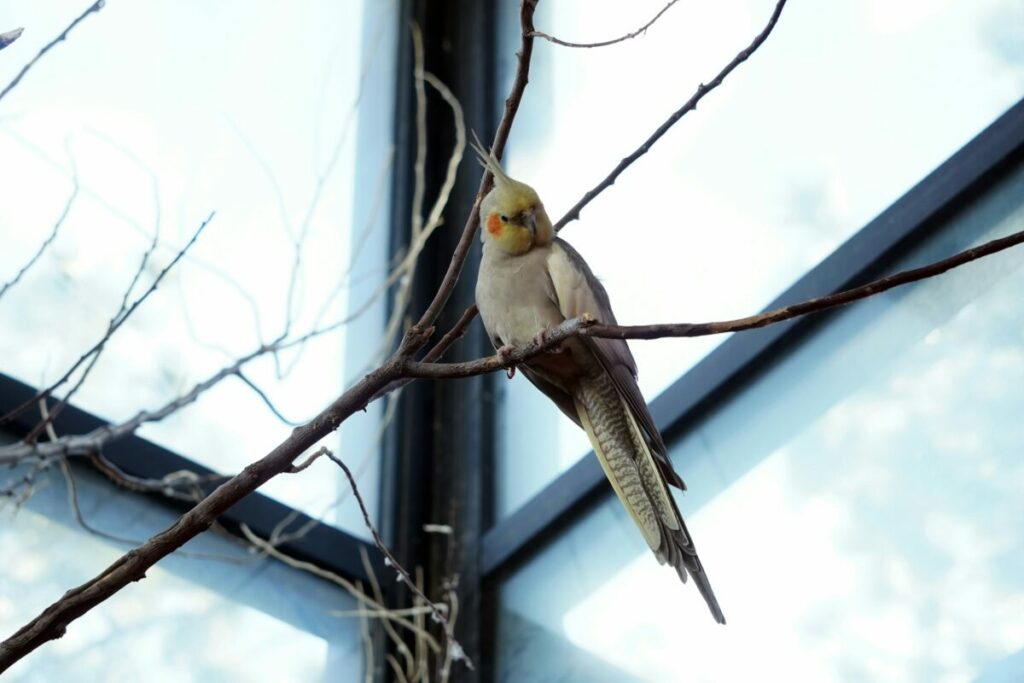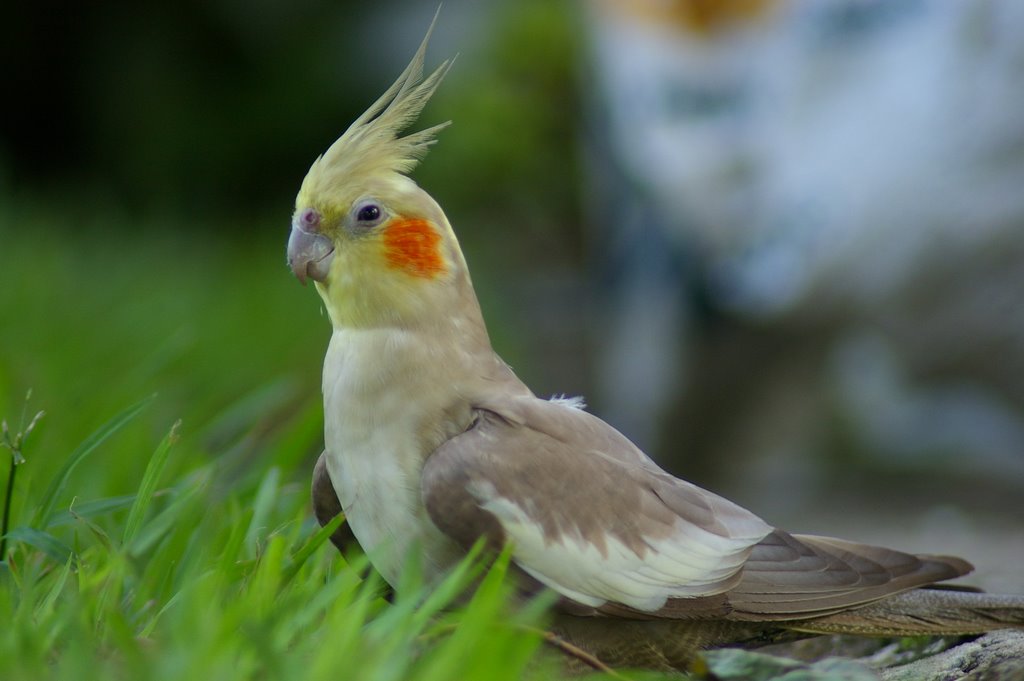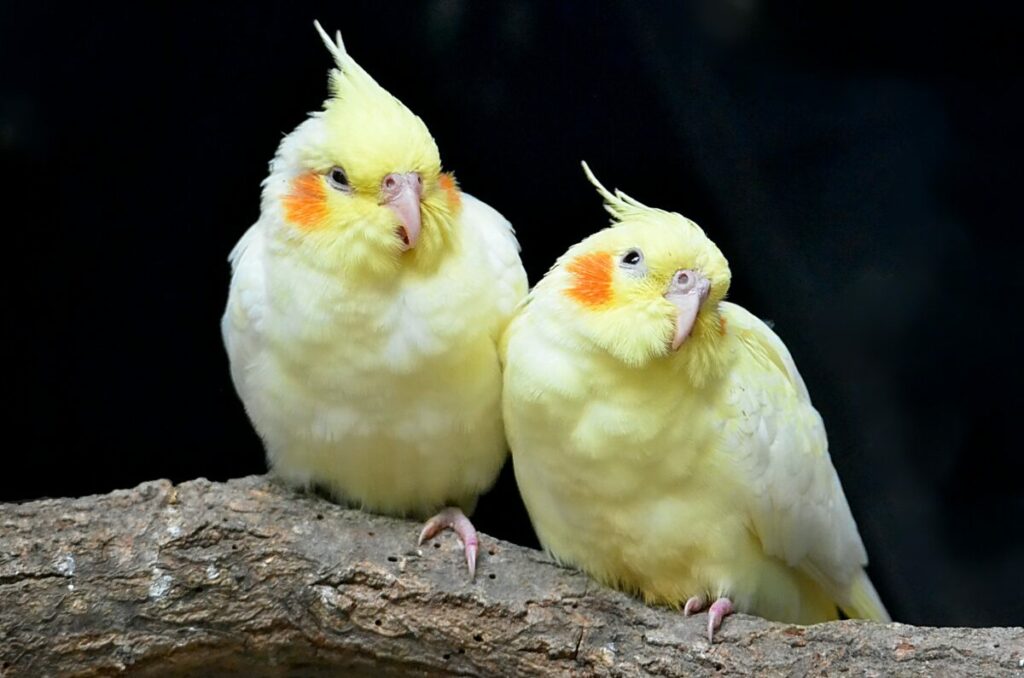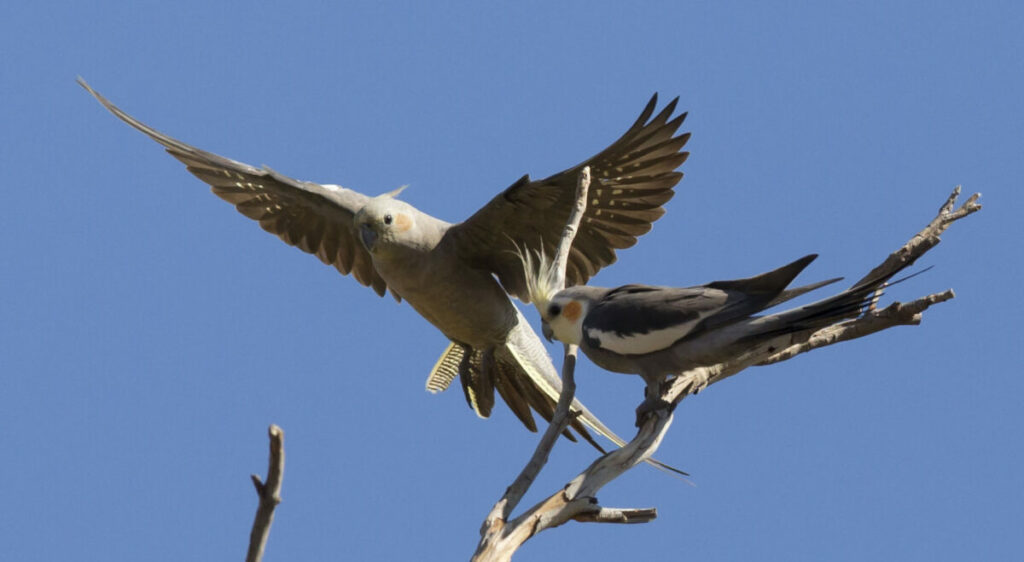Welcome to the exotic world of birds! Let’s dive in and explore one charming species – the Cinnamon Cockatiel. A fascinating mutation of the ever-popular Gray Cockatiel, these birds are equal parts elegance and social! Convenient enough to keep as pets, you might just find them becoming your new favorite companion.
The Cinnamon Cockatiel, a captivating variant of the typical Grey Cockatiel, exhibits an enchanting tan to brown plumage. This unique coloring results from a genetic mutation that alters the normal feather coloring. Distinguished by a sex-linked recessive gene, this mutation offers a window into the fascinating dynamics of avian genetics. These birds share many desirable traits as their Grey Cockatiel counterparts, making them equally beloved as pets.
Cinnamon Cockatiels require specific care to maintain their wellbeing, much like other pet birds. These care requirements include a spacious and secure cage allowing ample movement and exercise to promote physical health. Diet is another crucial aspect of their care; a balanced diet for a Cinnamon Cockatiel typically includes a variety of seeds, pellets, and fresh fruits and vegetables, ensuring they receive all needed nutrients. Health concerns are also similar to other cockatiels, so regular veterinary checkups are advised to keep these charming birds healthy.
As subdued as their plumage, the personality of a Cinnamon Cockatiel tends to be gentle and calm. This demeanor makes them suitable companions for those who appreciate a more relaxed bird friend. However, it’s important for prospective owners to understand that despite their generally laid-back nature, these birds still thrive on interaction and enrichment, requiring attention and mental stimulation to keep them content and engaged.
Cinnamon Cockatiel Origins and History

Being part of the parrot family, these birds carry an infectious zest and social nature. They share close relations with the cockatoo but sport a tail that stretches out much like a parakeet’s. An interesting feature is the erectile crest, which acts as an emotional indicator – when your little friend is excited, you’ll see an upright crest. But don’t be surprised if it’s flattened during its grumpy or defensive moments.
The Cinnamon Cockatiel is a testament to the complexity of avian genetics and the rich biodiversity of Australia. This section will explore the bird’s native habitat and the genetic twist that led to the cinnamon variation.
Native Habitat
The Cinnamon Cockatiel, a fascinating member of the Cockatoo Family, is indigenous to Australia. These birds reside there, in the vast, arid regions, flourishing within the country’s diverse ecosystems. Nymphicus hollandicus, the species’ scientific classification, indicates its Australian heritage and connection to the genus Nymphicus.
Origins of the Cinnamon Mutation
A unique mutation in the gene responsible for feather pigmentation led to the Cinnamon Cockatiel variant. This genetic shift alters melanin distribution, resulting in feathers tinged with an enchanting brown hue. The origin of this mutation traces back to avian ancestors in Australia, demonstrating nature’s propensity for variety within a species.
Physical Characteristics

These beauties can grow up to 12 inches – half of it is purely tail! A typical Cinnamon Cockatiel weighs approximately 3.5 ounces. As a pet, they develop an affection for toys, enjoy climbing, and can even learn to talk and whistle. Remember, these are social creatures who enjoy their fair chance at exercise – whether it’s flying around the house, or simply being in a large and spacious cage.
- Sociable and vocal, they are great pets for homes.
- Male Cinnamon Cockatiels are known to be better at talking and whistling.
- A spacious play area with climbing alternatives keeps them engaged.
Cinnamon Cockatiels captivate bird enthusiasts with their distinctive cinnamon-brown plumage, a result of a specific color mutation in their melanin. This section explores their coloration, size, and other unique physical traits.
Cinnamon Coloration and Plumage

Incessantly true to its name, the Cinnamon Cockatiel exhibits an irresistible allure that comes from its cinnamon color. A distinctive instance of a sex-linked mutation, this type stands out with its striking blend of brown, yellow, and cinnamon – adding to the entire body, eyes, feet, and even beak!
The Cinnamon Cockatiel is born with plum-colored eyes like other breeds. However, within a few weeks, these transition to a profound brown. The expanse of yellow is also much more pronounced in these birds, especially across their face and chests. Remember: age, the sun’s rays, and the overall health of your feathered friend can subtly alter these colors.
The hallmark of a Cinnamon Cockatiel is its warm, brown pigment in the feathers, a divergence from the standard grey. These birds display a variety of shades due to the cinnamon mutation, affecting the melanin and resulting in a softened feather coloration. Breed variations such as the Isabelle Cockatiel or Cinnamon Pearl Cockatiel showcase diverse patterns within this attractive palette.
Size and Weight
Cinnamon Cockatiels are generally slightly built, with adult specimens typically weighing around 3.5 ounces. Regarding dimensions, although their size may vary slightly, they typically mirror the standard Cockatiel size, possessing a balanced and proportionate stature suitable for their agile lifestyle.
Distinctive Features
Several features distinguish Cinnamon Cockatiels from their counterparts. Notably, their cheek patches exhibit a faded rosy hue. The Cinnamon Pied variant has irregular splashes of yellow and white throughout its body and wings. Additionally, their tail feathers and beak often appear paler than the standard grey Cockatiel, further exemplifying this bird’s subtle, yet alluring color mutation.
Behavior and Temperament
The behavior and temperament of Cinnamon Cockatiels are characterized by their sociability, propensity for vocalization, and interactive nature with humans. These attributes make them cherished pets known for their companionable essence.
Social Behavior
Cinnamon Cockatiels display robust social instincts, thriving in environments where they can interact with either their human caregivers or other birds. They exhibit an affectionate personality, frequently seeking engagement and displaying their sociable nature with gentle head bobs and wing flutters.
Vocalization and Speech
Known for a vocal repertoire that includes chirps and whistles, Cinnamon Cockatiels can mimic sounds and, to a lesser extent, human speech. Their intelligent demeanor makes them quick to pick up repetitive noises or melodies, although they may not reproduce human words as clearly as some other parrot species.
Interaction with Humans
With an inherently curious temperament, Cinnamon Cockatiels enjoy human interaction and can form strong bonds with their owners. They are fond of affectionate gestures like head scratches and often seek out the company of their human companions, demonstrating a trusting and companionable relationship.
Diet and Nutrition
Proper nutrition is critical for the health and longevity of Cinnamon Cockatiels. They require a mix of seeds, fruits, and vegetables to provide a varied and balanced diet essential for sustaining their health.
Feeding Habits
Cinnamon Cockatiels thrive on a regular feeding schedule that includes a variety of foods. They need a combination of pellets, as a stable source of nutrition, and a selection of fresh foods for additional vitamins and minerals. Water should always be available and refreshed daily to ensure hydration.
Seeds, Fruits, and Vegetables
Seeds: While an important component, seeds should only constitute about 30% of a Cinnamon Cockatiel’s diet due to their high fat content. They are best offered in combination with other foods rather than as a sole diet.
Fruits and Vegetables: Fresh fruit and vegetables are essential, making up 20% and 5% of the diet respectively. They provide vital nutrients and variety, focusing on offering those rich in calcium for healthy bone development. Avoid avocado, as it is toxic to birds.
Cockatiel Care and Husbandry
Proper care and husbandry are pivotal for a Cinnamon Cockatiel’s health and well-being. This section outlines the necessary provisions for their habitat and activities that facilitate their physical and mental stimulation.
Cage Requirements
Cage Size: For cockatiels, one must provide a spacious environment. A minimum cage size of 29 inches in length, 19 inches in width, and 26 inches in height is recommended. However, larger spaces are always preferable to allow room for flight and exercise.
Location: Locate the cage in a warm area free from drafts, with ample light during the day and darkness at night to maintain a healthy circadian rhythm. Avoid direct sunlight and kitchen fumes.
Features:
- Bar Spacing: Ensure the cage’s bars are no more than 5/8 inches apart to prevent escape or injury.
- Perches: Supply multiple perches of varying diameters to promote foot health. Natural branches can serve as excellent perches.
- Feeders and Waterers: Position these elements where droppings are least likely to contaminate them.
Security: It is essential that the cage has secure locks as cockatiels can be quite clever at opening latches.
Exercise and Enrichment
Daily Exercise: Cockatiels should be allowed supervised out-of-cage time daily for exercise and exploration, which helps to keep them robust and engaged.
Toys and Enrichment:
- Toys: Offer a variety of toys, including chewable options, puzzles, and mirrors to satisfy their curiosity and need to forage.
- Rotation: Regularly rotate toys to prevent boredom.
Interaction: Social encounters with their human companions are vital for their mental health. Training sessions using positive reinforcement can strengthen their skills and provide intellectual stimulation.
Environmental Enrichment: Adjustments within the cage, such as changing the perches’ locations or introducing new items, can provide a enriching environment and prevent stress.
Health and Common Issues
In caring for Cinnamon Cockatiels, understanding potential health concerns and nutritional needs is fundamental. Vigilance in healthcare and diet regimes is the key to preventing and addressing common issues that may arise in these birds.
Common Health Problems
Like their avian counterparts, Cinnamon Cockatiels can encounter health issues that require an owner’s attention. Respiratory problems can manifest from inadequate air quality or exposure to drafts, necessitating a watchful eye on their living environment. Obesity is another health concern that often stems from a diet overly rich in fats and insufficient exercise. Monitoring for signs like lethargy, weight loss, and ruffled feathers is crucial, as these can indicate underlying health problems.
Nutritional Needs
Maintaining a balanced diet is vital for the health of Cinnamon Cockatiels. They require a diet that provides an array of nutrients while limiting excess fat which can lead to obesity. A combination of high-quality commercial seed mixes and fresh fruits and vegetables provides a diet that meets their nutritional needs.
Foods rich in red, yellow, and white pigments, such as certain peppers and fruits, can also help maintain vibrant feather coloration. Chocolates and other sweets, however, must be avoided due to their toxicity to birds.
Breeding and Genetics
Successful breeding of Cinnamon Cockatiels hinges on a thorough understanding of genetic principles and meticulous breeding practices. Attention to sex-linked recessive traits is critical for breeders aiming to reproduce this specific mutation.
Breeding Practices
Breeder expertise and care are crucial when pairing Cinnamon Cockatiels. A breeder must consider the genetic makeup of female and male cockatiels, as these factors greatly influence the probability of producing offspring with the cinnamon trait. Meticulous record-keeping and careful selection of breeding pairs are fundamental to achieving desired results.
Genetic Inheritance
A sex-linked recessive genetic mutation characterizes the Cinnamon Cockatiel. This means the cinnamon trait is on the sex chromosomes, making the inheritance pattern more complex than simple recessives. In this case, a male Cockatiel needs only one cinnamon allele to show the coloration, while a female must have two. Understanding these genetic dynamics is vital for breeders who strive to predict and cultivate various color mutations in their aviaries.
Cockatiels as Pet Birds
Cockatiels have distinguished themselves as charming and affectionate pets, renowned for their intelligence and ease of care—qualities that make them admirable companions.
Choosing a Cinnamon Cockatiel
When considering a Cinnamon Cockatiel, selecting a captive-bred bird to support ethical breeding practices is essential. Adopt a cockatiel from reputable sources, where you can learn about the bird’s health and background. Prospective owners should seek cockatiels with bright, clear eyes and clean feathers to ensure good health.
Training and Companionship
Cockatiels thrive on companionship and can learn to perform various tricks. They may also learn to talk with consistent, gentle positive reinforcement. Interacting daily through training exercises and vocal mimicry can enhance your bird’s confidence and strengthen your mutual bond. Remember that each bird is unique; patience and consistency are key in nurturing a well-adjusted pet.
Finding These Cinnamon Feathery Friends

Despite their uniqueness, these Cinnamon Cockatiels are not elusive. You can easily find one, depending on the regional availability. If they aren’t readily on display at your local pet shop, just ask – they can generally place a special order for you. So, why ponder? Make the most of this advice and bring a charming Cinnamon Cockatiel into your family today!